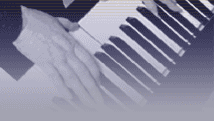



|
• home
|
• bio
|

|
Instruction: Piano Accompaniment Notes Practice the rhythms of different types of tunes by clapping your hands in time while you listen to music. Don’t even use the piano at this point -- just practice rhythm. Jigs are 6/8; reels are 4/4. Learn the basic scales and chords that apply to tunes in major and minor keys. Familiarize yourself with the 1,4 and 5 chord of each key. These will correspond with the first, fourth and fifth note of the scale of the keys. You will play the 1,4, and 5 chord most often. Practice the scales of the keys of D, G, and A; these are very common fiddle tune keys. Ask a fiddler to record some tunes on tape for you (preferably some that are familiar to you), playing them over and over, slowly at first, gradually building up to speed. When you play them back (to accompany them) you won’t have to keep rewinding the tape. You can also play along with commercial recordings. If you are brand new to accompanying, your success happens when you realize you have played the WRONG chord. This means your ears are working!!! Another good method is to play along and just play the base note (in an octave if possible) and don’t play any chords. You will usually always play two of the same note. For example, follow this pattern: (in base notes) 11-44-11-55-11-44-1-5-11 (end of first part of tune, 16 bars). This pattern applies to many jigs and reels; try it first, but don't depend on memorizing a pattern, try to use your EAR. Use the most basic accompaniment—boom chuck—which is usually one base note in left hand, one three-note chord in the right. After you are comfortable making the chord changes using this structure, add a base note in the left hand, (making that an octave) and add a fourth note to your right-hand chord, so that the chord should be (RH) 1-3-5-1 (notes). Practice inversions of chords up and down the keyboard. Start at or just above middle C. Play the "1" chord (three-note chord) inverting up as far as you can go, then come down with the "4" chord, back up again with the "5" chord, back down again with the "1". (Right hand only.) Practice playing in different positions on the keyboard; don’t just "hover" around middle C. Don’t play too high up the keyboard either (right hand). The piano is also a percussion instrument. So, rhythm is important--more important than the correct chords. Pay attention to the tempo of the main melody maker. Don’t be so wrapped up in playing the correct chords that you forget. If you don’t get a chord one time around, don’t worry, you’ll get it next time or the time after. NEVER stop - keep going. Stopping can put you and everyone else out of sync. Monitor the volume of your playing. NEVER be louder than the main melody instrument, or in a band situation, the rest of the instruments. The fiddle, in particular, in a very small instrument compared to a piano. If you are working with sound equipment, ask the sound person to adjust your volume so that you are never louder than the rest. That way, you can be comfortable. Do not play heavily all the time--vary your touch. Use the sustain
pedal moderately, but use it. Do not
carry chord sounds into one another
i.e. let up on the pedal after one
chord so that sound doesn’t
carry into the next different chord you
play. |
